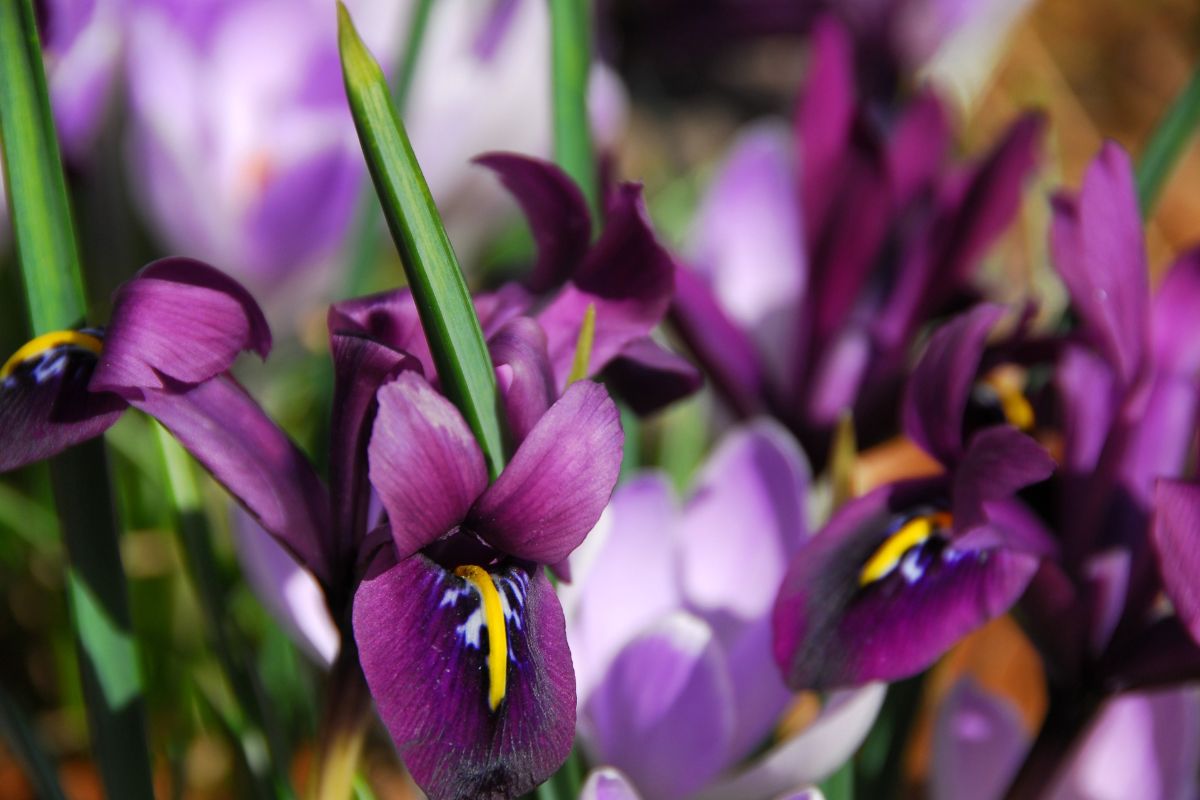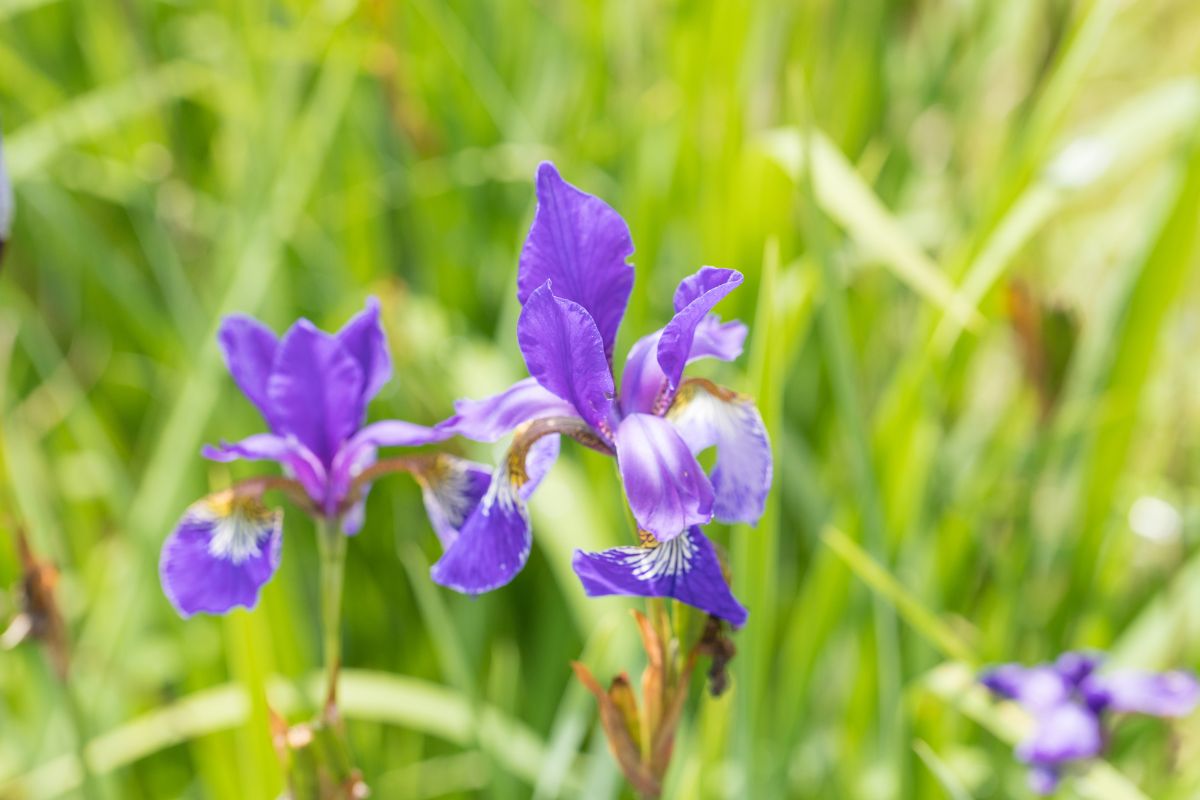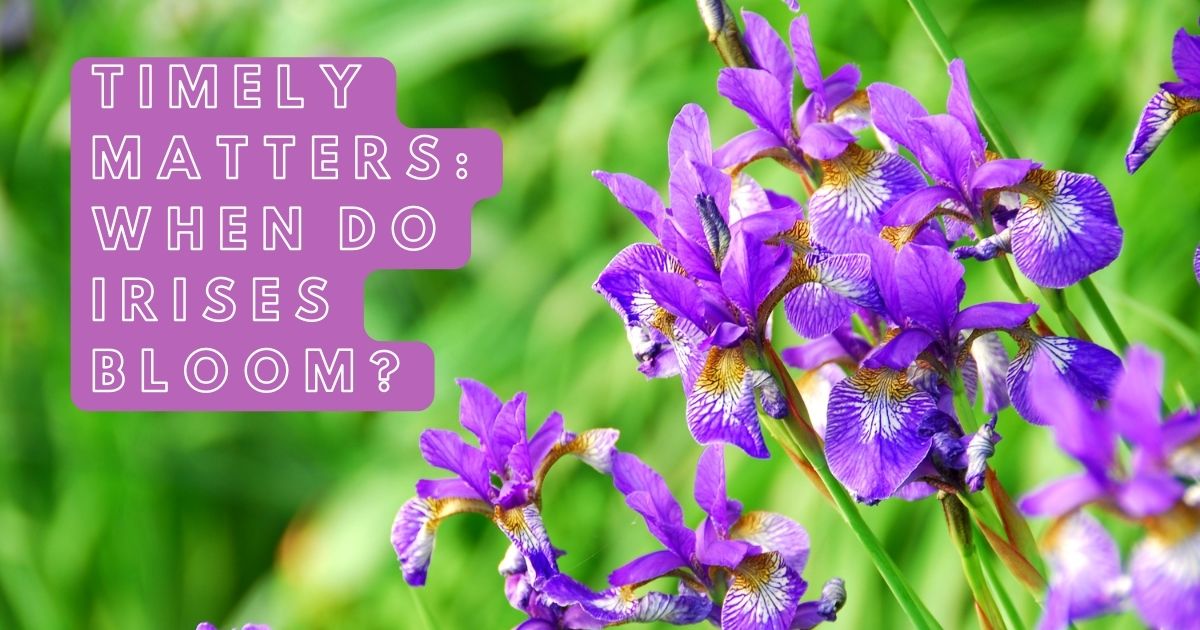If you’ve ever seen a tall, beautiful flower with magical colors, then that is an Iris. People named it after a Greek goddess who rode a rainbow, but when do Irises Bloom? Well, this is a question that many people ask themselves.
Here is a brief description of Irises. Nonetheless, you will learn about the different types of Irises, when they bloom and what to do with them after blooming. So, let’s dive in.
But before going deeper, what is the appearance of this beautiful flower?

What Does an Iris Look Like?
What does an Iris look like? An Iris is a hardy herbaceous perennial plant. It comes from the Iridaceae family and has colorful and fragrant flowers that bloom on tall, sturdy stems. This makes them beautiful during summer and fall.
Nonetheless, this gorgeous plant has uniquely structured flowers. Generally, you can identify an Iris by its three upright petals sitting atop three larger, pendent sepals.
Planting Irises
Planting an Iris flower should not give you a hard time. Furthermore, giving them the proper growth requirements will make them thrive well. But it is vital to understand the best location, soil, and time to plant these flowers.
When to Plant an Iris
You cannot plant an Iris anytime you want. However, this plant has seasons that will make it thrive and bloom in large numbers. Additionally, early autumn or late summer is an excellent season to plant Iris rhizomes or bulbs.
This is vital since it will give them plenty of time to establish roots before the growing season ends. In hotter climates, you can plant them in September or October.
Where to Plant an Iris
Location for planting Irises is also crucial. It’s best to select a sunny spot because there’s no standing water. Also, ensure that it is a raised bed for good drainage.
How to Plant an Iris
How to plant Iris bulbs? Planting Irises requires you to follow some basic steps. First, prepare the planting beds two weeks ahead. To do this:
- Loosen the soil to 10 to12 inches (25 to 30 centimeters) for proper drainage
- For better results, add organic matter
- Ensure that the Iris rhizomes are slightly visible on the soil surface
- If not, cover them in warm climates
Nonetheless, you need to top dress with a low-nitrogen fertilizer to minimize rotting. Next, make a row in the soil, put the rhizome on the ridge, and spread the roots on all sides.
Soli Requirements
Typically, the Irises flower prefers average to be fertile, neutral to slightly acidic, and well-drained soil. This will enable them to stay healthy and bloom well.
When do Irises Bloom?
When do Irises bloom? There are many types of Irises. However, most of them bloom from late spring to early summer. Bearded varieties may bloom in late summer, then Siberian Irises. After they bloom, they attract insects such as butterflies. On top of that, providing full sun; for at least 6 to 8 hours per day will make them bloom faster.
Also, provide well-drained, fertile soil. Still, on blooming, each variety blooms for about two weeks. However, this depends on the weather. If they don’t bloom, then something is not correct. Maybe you are not giving it proper care. If all is good, divide and replant them.
What to do With Irises After they Bloom
Everyone loves these beautiful flowers. They contain a lot of colors that resemble a rainbow. When they bloom, they create beautiful scenery—also, it is home to butterflies and hummingbirds. But what to do with Irises after they bloom? Let’s find out.
Deadheading
After your Irises have bloomed, remove the dead blossoms to prevent the plants from using their energy while ripening the seed heads. If they don’t bloom, then they are overcrowded. When this happens, dig up and separate the bulbs.
Cut
After your Irises finish blooming, cut them. Cut the flower stems down to their base to discourage rhizome rot. On the contrary, do not trim the leaves. Because the plant’s foliage continues with photosynthesis and produces energy for the next season, generally, doing this will attract a healthier and more attractive plant.
How to Get Iris to Bloom Again
Irises are the flowers that everyone would wish to have in their garden or patio. Taking good care of them will enhance blooming. The beautiful flowers will make you want to plant more. So how do I get Iris to bloom again? Here are the important things to do.
Check the Depth of the Rhizome
To make your Irises bloom again, check the depth of the rhizome. A rhizome is simply a stem located at the surface level or underground. It has a series of nodes where the roots grow.
Since they grow perpendicular to the ground, check the depth of the rhizome. If they are too deep, the irises will fail to bloom. To enhance blooming, put them under the soil.
Check on the Sunlight Condition
One of the most common reasons Irises fail to bloom is inadequate sunlight. However, some people plant in partial sunlight. So yes, they can grow in partial shade. Just ensure that your irises get enough sunlight.
Most iris varieties need at least six hours of sun daily to bloom. If they are in a shaded region, consider transplanting them to a more open area to receive more sun.
Protection From the Spring Frost
Early spring frost can be the deadly season for your Irises and cause death. If you want your Irises to bloom again, protect them from that early spring frost. Then, once the plant has produced buds, apply proper maintenance.
If not, the buds will die early and will fail to bloom. To offer protection, Get a light fabric on a pole to surround the plant. Remember that the cover should go to the ground since it will trap the heat around the plant. Usually, frost occurs at night, so you need to cover it early. Then, when morning comes, remove the cover.
Fertilize the Plant
You should fertilize the irises when they begin growing. Then, to bloom again, apply the fertilizer a month after they bloom. This will keep the plant healthy and will improve its quality.
Always use a fertilizer that is labeled and suitable for bulbs to prevent bulbs from adding excess amounts. Remember to add at least one inch of water to the plant when fertilizing it.
Remove the Blooms
Once the Iris blooms have faded, move them carefully with a pair of scissors to cut the stalks. If you don’t have scissors, use a hand clipper. This will help conserve energy for the iris plant, for it to rebloom again and enjoy its varieties’ beautiful colors.
Divide the Irises
The best way for Irises to bloom is to divide them more when overcrowding. If you think the plants produce fewer flowers than they should, transplant them across the garden. Also, cut and remove the dead foliage during late summer, so the plant has plenty of space to grow.
These are just a few important things for your irises to bloom again. Follow these essential steps and check on your plants regularly.

Front Yard Landscaping With Irises
Front yard landscaping with Irises is a thing that many gardeners put into consideration. However, when many approaches, this is when the need arises. This is because it is Iris blooming season. After they bloom, you will notice a rainbow color from the long-stemmed and branched flowers.
The gorgeous colors make them beautiful, especially for the front yard. Moreover, Irises provide the front yard landscape with its most spectacular color for a long. The best part is that front yard landscaping with Irises enhances the grouping of colors and sizes to your liking. Truly, Irises combine well with other varieties to create a handsome look.
Do Irises Need Full Sun?
Do Irises need full sun? Irises are flowers that need care to thrive well. For them to bloom, they need adequate fertilizer, well-drained soils, and sunlight. But do they need full sun? Well, Irises require total care to bloom effectively.
You should give it at least 6 to 8 hours of sunlight daily. Nonetheless, they can tolerate as little as half a day of sun, but it’s not advisable. Sunlight is essential because it will prevent wilting. So, give it full sun and enjoy the Bloom.
The Different Types of Irises
Irises are beautiful flowers that add beauty to gardens and compounds. Their appearance makes them suitable for areas such as the front yard, garden, and patio. However, they come in different types. Here are the main varieties of Irises:
Bearded Iris
The bearded IrisIris is common among everyone. The term bearded came to be because of the downward-facing petals resembling a tongue sticking out. They grow best in late summer or early fall in full sun.
Plant the rhizomes to see them above the soil because they thrive with good air circulation and sunshine. With good drainage and dividing, your Irises will thrive well since they’ll be overcrowding hence less competition.
Dwarf Bearded Iris
Dwarf bearded Iris is another variety of Iris. It grows eight to 15 inches (20 to 38 centimeters) high. They are known to multiply so that you can populate a vast garden area. This will save money since you’ll need a few plants.
Dwarf Crested Iris
Dwarf crested Iris is unique since it grows best in partial shade. The 6-inch (15 centimeters) high flowers start appearing from March to May and will attract hummingbirds and bees to your garden. Since they grow in the wild, they give them acidic soil to meet their growth requirements. Like the bearded IrisIris, this variety spreads through rhizomes.
Bamboo Iris
Bamboo Iris contains many species. However, they do well in remote locations, so many people prefer not to grow them. For this reason, plant them in special nurseries.
Dutch Iris
Just like the bamboo Iris, the dutch Iris is an almost forgotten variety of Iris. But, as much as many gardeners overlook them, they are good companion plants. Unlike the bearded IrisIris, which grow from rhizomes, these are bulbous Irises. So, you should plant them deeply.
Japanese Iris
Another lesser-known variety is the Japanese Iris. The good thing is that they bloom in large numbers. Furthermore, the Japanese IrisIris demands constant moisture, full sunlight, and rich soil. For this reason, plant them near a pond or stream-side garden where the soil stays wet.
Siberian Iris
The Siberian Iris is a subgroup of the beardless division but has no beard. However, they bloom slightly later than the bearded Iris, providing a color bridge to summer perennials. However, they maintain elegant waving foliage throughout the season.
This plant grows from sturdy, fibrous rhizomes, but when the center of the crown becomes woody and non-productive, you need to divide them. Apart from being drought tolerant, they appear in blue, violet, or purple.
Yellow Flag Iris
This vibrant and vigorous plant spreads as far as it can. However, since it spreads aggressively by rhizomes, it is wise to plant it in a container to control it.
Louisiana Iris
Last but not least is the Louisiana Iris. It has white, purple, and yellow. They are naturally occurring in their native boggy, swampy habitats. As the name suggests, this variety is the most prevalent in the Gulf Coast area. For this reason, most Louisiana Irises prefer mild temperatures, moist spring weather, and slightly acidic, sandy soil.
Other Design Ideas Using Irises
As mentioned earlier, Irises bloom well when given adequate growth requirements, such as the full sun. Healthy Irises contain a lot of uses. Since they come in different colors and sizes, they’ll suit every part of your garden. Other design ideas using irises include;
Poolside Planting
The first design idea while using Irises is planting on the poolside. The pool is a place that many people love. Yes, some swim to rewind from the busy weak, while others sit enjoying a cold drink from the hot sun. Planting them poolside will up the beauty and raise the spirits high. The good thing is that they bloom for quite some time.
Mixing
Another design idea while using an Iris is mixing. There are different varieties, such as bearded and Siberian. When combined, they appear colorful. For instance, you can mix Siberians and Japanese IrisIris for blooming early spring through fall.
Cut flowers
Many plants act as cut flowers, but nothing beats Irises. They make excellent cut flowers and cut them when the topmost flower is just beginning to open. For this reason, vase longevity is affected by temperature, with a maximum vase life of about one week. To keep multi-flowered irises looking fresh and pretty, trim from the top down as flowers open and fade.
Incorporate Companions
Another design idea while using an Iiris is incorporating better companions. Some best companions are lavender, daylily, blanket flower, sedum, and coneflower. These blossoms make perfect additions to perennial borders. For instance, you can plant taller varieties with shrubs.
When planted with sage, they provide a beautiful contrast with ornamentals. On the contrary, you should prevent them from being overcrowded. Instead, ensure that you grow them where you can enjoy a beautiful view, such as butterflies and hummingbirds.

Final Thoughts
An Iris is a beautiful flower with an array of colors. When they bloom, they resemble a rainbow. These plants require adequate care to bloom; If not, they will die. They are also beautiful for the front yard landscape. Other than that, you can take a bunch and gift your loved one. But remember, they need proper growing requirements to bloom effectively.
